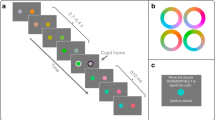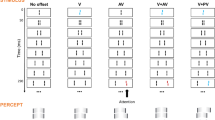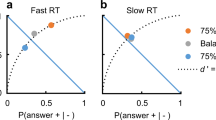Abstract
Continuous, predictable events and spontaneous events may coincide in the visual environment. For a continuously moving object, the brain compensates for delays in transmission between a retinal event and neural responses in higher visual areas. Here we show that it similarly compensated for other smoothly changing features. A disk was flashed briefly during the presentation of another disk of continuously changing color, and observers compared the colors of the disks at the moment of flash. We also tested luminance, spatial frequency and pattern entropy; for all features, the continuously changing item led the flashed item in feature space. Thus the visual system's ability to compensate for delays in information about a continuously changing stimulus may extend to all features. We propose a model based on backward masking and priming to explain the phenomenon.
This is a preview of subscription content, access via your institution
Access options
Subscribe to this journal
Receive 12 print issues and online access
$209.00 per year
only $17.42 per issue
Buy this article
- Purchase on Springer Link
- Instant access to full article PDF
Prices may be subject to local taxes which are calculated during checkout





Similar content being viewed by others
References
Nijhawan, R. Motion extrapolation in catching. Nature 370, 256–257 (1994).
Nijhawan, R. Visual decomposition of colour through motion extrapolation Nature 386, 66–69 (1997).
Berry, M. J., Brivanlou, I. H., Jordan, T. A. & Meister, M. Anticipation of moving stimuli by the retina. Nature 398, 334–338 (1999).
Cavanagh, P. Predicting the present. Nature 386, 19–20 (1997).
Zeki, S. The representation of colour in the cerebral cortex. Nature 284, 412–418 (1980).
Hartline, H. K. The response of single optic nerve fibers of the vertebrate eye to illumination of the retina. Am. J. Psychol. 57, 243–249 (1938).
Kuffler, S. W. Discharge patterns and functional organization of mammalian retina J. Neurophysiol. 16, 37–68 (1953).
Hubel, D. H. & Wiesel, T. N. Integrative action in the cat's lateral geniculate body. J. Physiol. (Lond.) 155, 385–398 (1961).
Campbell, F. W., Cooper, G. F. & Enroth-Cugell, C. The spatial selectivity of the visual cells of the cat. J. Physiol. (Lond.) 203, 223–235 (1969).
Schiller, P. H., Finlay, B. L. & Volman, S. F. Quantitative studies of single-cell properties in monkey striate cortex. III. Spatial frequency. J. Neurophysiol. 39, 1334–1351 (1976).
Schiller, P. H., Finlay, B. L. & Volman, S. F. Quantitative studies of single-cell properties in monkey striate cortex. I. Spatiotemporal organization of receptive fields. J. Neurophysiol. 39, 1288–1319 (1976).
Albright, T. Direction and orientation selectivity of neurons in visual area MT of the macaque. J. Neurophysiol. 52, 1106–1130 (1984).
Hammond, P. & MacKay, D. M. Differential responses of cat visual cortical cells to textured stimuli. Exp. Brain Res. 22, 427–430 (1975).
Jonides, J. & Yantis, S. Uniqueness of abrupt visual onset in capturing attention. Percept. Psychophys. 437, 346–354 (1988).
Baldo, M. V. C. & Klein, S. A. Extrapolation or attention shift? Nature 378, 565–566 (1995).
Khurana, B. & Nijhawan, R. Extrapolation or attention shift? Nature 378, 565–566 (1995).
von Helmholtz, H. Handbuch der Physiologischen Optik II 240–245 (Verlag von Leopold Voss: Hamburg und Leipzig, 1909).
Wohlgemuth, A. On the aftereffect of seen movement. Br. J. Psychol. Monogr. Suppl. 1, 1–117 (1911).
Snowden, R. J. Shifts in perceived position following adaptation to visual motion. Curr. Biol. 8, 1343–1345 (1998).
Nishida, S. & Johnston, A. Influence of motion signals on the perceived position of spatial pattern. Nature 397, 610–612 (1999).
Suzuki, S. & Cavanagh, P. Focused attention distorts visual space: An attentional repulsion effect. J. Exp. Psychol. Hum. Percept. Perform. 23, 443–463 (1997).
Blakemore, C. & Sutton, P. Size adaptation: a new aftereffect. Science 166, 245–247 (1969).
DiLollo, V. Temporal integration in visual memory. J. Exp. Psychol. 109, 75–97 (1980).
Coltheart, M. Iconic memory and visible persistence. Percept. Psychophys. 27, 183–228 (1980).
DiLollo, V. & Bischof, W. F. Inverse-intensity effect in duration of visible persistence. Psychol. Bull. 118, 223–237 (1995).
Purushothaman, G., Patel, S. S., Bedell, H. E. & Ogmen, H. Moving ahead through differential visual latency. Nature 396, 424–424 (1998).
Whitney, D. & Murakami, I. Latency difference, not spatial extrapolation. Nat. Neurosci. 1, 656–657 (1998).
Eagleman, D. M. & Sejnowski, T. J. Motion integration and postdiction in visual awareness. Science 287, 2036–2038 (2000).
Maunsell, J. H. & Gibson, J. R. Visual response latencies in striate cortex of the macaque monkey. J. Neurophysiol. 68, 1332–1344 (1992).
Turvey, M. T. On peripheral and central processes in vision. Psychol. Rev. 80, 1–52 (1973).
Breitmeyer, B. G. Visual Masking: An Integrative Approach (Oxford Univ. Press, New York, 1984).
Bachmann, T. Psychophysiology of Visual Masking (Nova, Commack, New York, 1994).
Bartram, D. J. The role of visual and semantic codes in object naming. Cognit. Psychol. 6, 325–356 (1974).
Marcel, A. J. Conscious and unconscious perceptions: An approach to the relations between phenomenal experience and perceptual processes. Cognit. Psychol. 15, 238–300 (1983).
Efron, R. Conservation of temporal information by perceptual systems. Percept. Psychophys. 14, 518–530 (1973).
Brainard, D. H. The Psychophysics Toolbox. Spat. Vis. 10, 443–446 (1997).
Pelli, D. G. The Video Toolbox software for visual psychophysics: tranforming numbers into movies. Spat. Vis. 10, 437–442 (1997).
Boynton, R. M. & Kaiser, P. K. The additivity law made to work for heterochromatic photometry with bipartite fields. Science 161, 366–368 (1968).
Finney, D. J. Probit Analysis (Cambridge Univ. Press, Cambridge, UK, 1971).
McKee, S. P., Klein, S. A. & Teller, D. Y. Statistical properties of forced-choice psychometric functions: Implications of probit analysis. Percept. Psychophys. 37, 286–298 (1985).
Foster, D. H. & Bischof, W. F. Thresholds from psychometric functions: Superiority of bootstrap to incremental and probit variance estimators. Psychol. Rev. 109, 152–159 (1991).
Acknowledgements
This research was supported by NSF grant SBR-9710116 and a Caltech Division of Biology fellowship awarded to B.R.S. We thank Johanna Weber for reviewing our manuscript, Christian Scheier for providing the statistics software, Gabriel Kreiman for help with printing and Chris Tyler for suggestions on improving the pattern-entropy experiment.
Author information
Authors and Affiliations
Corresponding author
Rights and permissions
About this article
Cite this article
Sheth, B., Nijhawan, R. & Shimojo, S. Changing objects lead briefly flashed ones. Nat Neurosci 3, 489–495 (2000). https://doi.org/10.1038/74865
Received:
Accepted:
Issue Date:
DOI: https://doi.org/10.1038/74865
This article is cited by
-
A delay in sampling information from temporally autocorrelated visual stimuli
Nature Communications (2020)
-
Distinct mechanisms of temporal binding in generalized and cross-modal flash-lag effects
Scientific Reports (2019)
-
Evolution of a predictive internal model in an embodied and situated agent
Theory in Biosciences (2011)
-
Memory-Prediction Errors and Their Consequences in Schizophrenia
Neuropsychology Review (2009)
-
Dynamic shifts in the owl's auditory space map predict moving sound location
Nature Neuroscience (2006)



